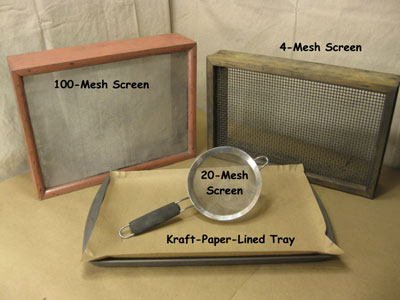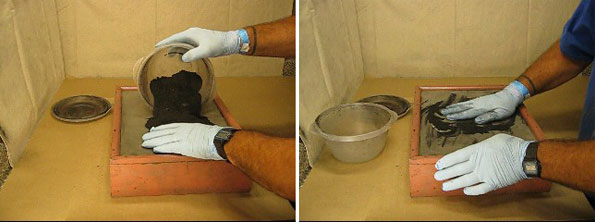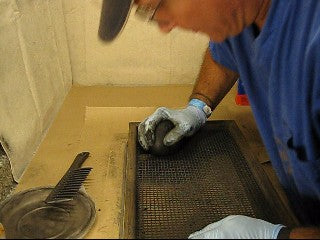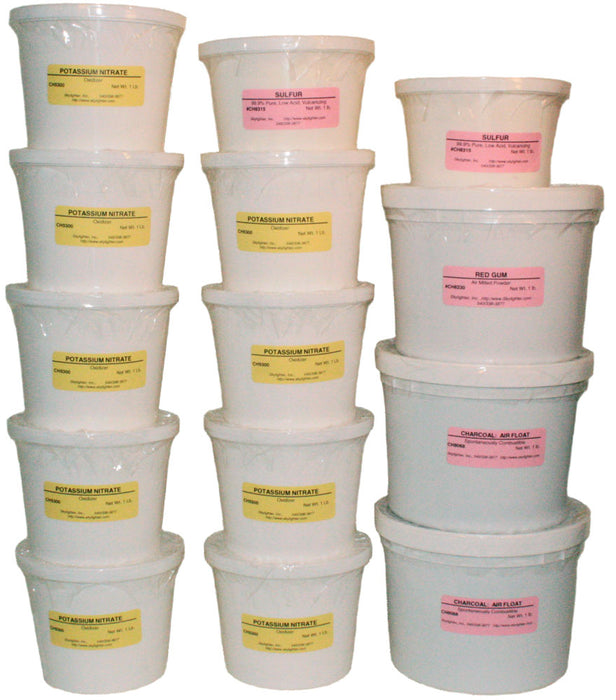Homemade Black Powder, Red Gum Binding, Screen Granulated
Black Powder, otherwise known as BP, is used for various purposes in fireworking: lift powder for aerial shells and comets and mines, burst powder for shells and rocket headings, propellant in roman candles.
Commercial fireworks manufacturers have traditionally used commercial black powder, and that's what beginning hobbyists typically use, too. Online sources such as Graf and Sons, http://www.grafs.com/powders/3522, will ship black powder to your door. Some gun shops and sporting-goods stores still stock it, too.

Goex Brand Black Powder
But at some point, most fireworks hobbyists decide to try their hand at making their own black powder, whether for economic reasons or a desire for more self-sufficiency in their artistic pursuit.
"There must be a better way", we thought. And there is. On the various pyrotechnic conversation lists, a recurring discussion pops up again and again about the almost endless variables that make good black powder.
Often, the variables most discussed are:
But, this tutorial is aimed at beginning fireworkers who want to try their hand at making their own homemade BP, without diving into the investment in a ball mill, or the challenge of making their own charcoal, yet.
With a small collection of hand equipment, and a few basic, readily available chemicals, can a functional beginner's BP be easily made? Will this black powder work for lifting homemade aerial shells, and then bursting them up in the air? These are the questions we'll be addressing.
One additional chemical is used in the method we're about to explore: red gum. It is used in this process as a binder to make the resulting black powder granules a little harder than if it was not used. The red gum will be dissolved in denatured alcohol.


Note: Whenever working with volatile solvents which put fumes into the air, work outdoors or in a very well ventilated, open shelter. These fumes can accumulate in an enclosed space, potentially causing a fire or explosion. Also use a Paint-Spray Respirator, rated for organic vapors.
Three mesh-sizes of sifting-screens will be necessary: 100-mesh, 20-mesh, and 4-mesh. A kraft-paper lined tray will also be required. For more information on pyro-screens, see: "Weighing and Screening Chemicals for Fireworks"

You will need to pulverize your potassium nitrate fine enough to pass through the 100-mesh screen. The most basic way to do this is with a blade-type coffee mill.
Note: Never grind mixtures of chemicals in a coffee mill because they can ignite or explode.
Blade-Type Coffee Mill Grinding Individual Chemicals
The other standard pyrotechnic utensils and equipment will be required: weighing scale, mixing tubs, scoops, paper cups, roll of kraft paper, etc.
A clean plastic or glass jar, with a lid, will be needed in which to dissolve the red gum in the alcohol.
The airfloat charcoal and sulfur typically come fine enough to pass the 100-mesh screen. They both go through much more easily if they are mixed with each other and with the potassium nitrate, though. Do verify that each individual chemical is ground fine enough to pass on its own, though, by testing a little of it.
Mill small batches of the potassium nitrate in the coffee mill until it will pass the 100-mesh screen. Don't overheat your coffee mill and ruin it. Re-mill what will not go through the screen pretty easily. Repeat this until you have at least the 7.5 ounces of fine KNO3 needed in the formula above.
Note: A 100-mesh screen means a 100-mesh screen. It doesn't mean a "Oh, a 40-mesh screen will be good enough" screen. This step, getting the chemicals to pass a 100-mesh screen, is the single most important step in the process of making functional black powder in this simple way. Seriously, use a 100-mesh screen, or don't complain about your results. This fine granulation is substituting for ball-milling, and it is necessary to ensure that the particles are as fine as possible.

Dissolving Red Gum in Denatured Alcohol
Note: Working over a kraft-paper-lined tray can really minimize messes from spilled powders or liquids.
Note: It's very easy to forget to hold the lid on the tub while shaking it, or to think it's not necessary. Then it's very easy for the lid to pop loose and you'll have black powder composition flying everywhere. Hold the lid on with your hand while shaking the tub, seriously.
Open the tub and pour the contents onto the 100 mesh screen, which is sitting on a sheet of kraft-paper. Gently work the composition through the screen with gloved hands.
Note: This is now a highly flammable and dusty composition. Don't grind the composition against the screen with fingernails or jewelry. Perform this task outdoors in a location with calm air. Wear cotton clothing while performing this operation. Stay far away from any source of sparks or flame.
Pour the screened composition from the kraft-paper back into the mixing tub. After replacing the paper under the screen, repeat the screening process for a second time. Then repeat the whole process for a third time.
When the composition is back in the tub, cap it with the lid and gently shake it again while holding the lid on tightly.

Screen-Blending Composition through a 100-Mesh Screen
Work the moisture into the dry composition with gloved hands until it becomes a damp and glistening ball of putty. Don't add the last remnants of the solution until you're sure the putty needs it to get to that state. If necessary add very small amounts of pure alcohol if the red-gum solution has all been used and the putty still needs a bit more moisture.
The putty ball should be soft and pliable, and glistening a little with the moisture, but still should be able to hold its shape well. Getting the putty ball wet enough will help the dried BP granules be as hard and durable as possible.

Black-Powder Composition Dampened with Red-Gum and Alcohol

Use a coarse-toothed comb to gently spread the damp granules out in an even layer.
Spreading Black Powder Granules
Put the tray in a warm, breezy location, safe from any sources of ignition or tampering by kids or animals.
After about an hour and a half, turn the drying granules by rolling them back and forth in the kraft paper, and spread them out evenly again.
A total drying time of about 2-3 hours will be required for the granules to be completely dry. Overnight in a dry, safe location is even better. When the powder is dry, it should have stopped smelling of alcohol, and the granules will have attained a stiff texture and will be a flat-gray color.
Avoid static discharge or unnecessary friction when handling this black powder.
The fine powder can have alcohol added to it and can be re-granulated into a more coarse powder. Or it can be saved to use as a black-powder prime on stars or comets.
Note: This dry black powder is a powerful explosive. It is to be treated with respect. Its dust is highly flammable. It needs to be stored in accordance with all safety procedures and all pertinent laws.
Screen-Sorting BP Granules
This BP is almost as powerful as commercial powder, though. In practice, about 3/4 of an ounce of commercial BP is used to lift a 3" aerial shell about the same size and weight as a baseball. With this red-gum black powder, approximately 0.9 ounce will be required.
Whereas 4 grams of FFg Goex commercial powder is needed to lift a 1.75" festival ball shell, about 7-10 grams of this homemade powder will be needed.
It helps, when lifting aerial shells with this BP, if the fit of the shell in the mortar is relatively snug, with about 1/32" clearance all around the shell as it's loaded in the gun.
This rocket heading was burst with red-gum BP. The paper cylinder shell heading was reinforced with strapping tape to really contain the shell's contents until it built up pressure and burst.

Paper Cylinder Shell Rocket-Heading, Burst with Red-Gum BP

Enough chemicals to make almost 12 pounds of high quality black powder.
Commercial fireworks manufacturers have traditionally used commercial black powder, and that's what beginning hobbyists typically use, too. Online sources such as Graf and Sons, http://www.grafs.com/powders/3522, will ship black powder to your door. Some gun shops and sporting-goods stores still stock it, too.

Goex Brand Black Powder
But at some point, most fireworks hobbyists decide to try their hand at making their own black powder, whether for economic reasons or a desire for more self-sufficiency in their artistic pursuit.
Homemade Black Powder
Many of us, as kids, played with mixing potassium nitrate (KNO3), charcoal, and sulfur, in the traditional proportions of 75/15/10. Putting the hand-stirred mixture in a pile, we were often disappointed with the results: a smoldering, slow-burning pile which left a yellow molten pool of debris behind after it finished burning."There must be a better way", we thought. And there is. On the various pyrotechnic conversation lists, a recurring discussion pops up again and again about the almost endless variables that make good black powder.
Often, the variables most discussed are:
- Ball milling
- Type of charcoal
- The method used to granulate the BP
- The size of the granules to be used in a particular application
- The final hardness and density of the granules
- Methods for testing and comparing BP
But, this tutorial is aimed at beginning fireworkers who want to try their hand at making their own homemade BP, without diving into the investment in a ball mill, or the challenge of making their own charcoal, yet.
With a small collection of hand equipment, and a few basic, readily available chemicals, can a functional beginner's BP be easily made? Will this black powder work for lifting homemade aerial shells, and then bursting them up in the air? These are the questions we'll be addressing.
The Chemicals
Three basic chemicals are found in black powder: potassium nitrate (KNO3), charcoal (made from wood, not charcoal briquettes), and sulfur. These components are readily available from pyrotechnic suppliers such as Skylighter.One additional chemical is used in the method we're about to explore: red gum. It is used in this process as a binder to make the resulting black powder granules a little harder than if it was not used. The red gum will be dissolved in denatured alcohol.

Note: Use denatured alcohol, specifically, as shown above, from paint-departments of stores like Home Depot. Do not use isopropyl rubbing alcohol, which can have water, perfume oils, or colorants in it: additives which will degrade the performance of your homemade black powder.
Necessary Equipment
Working with this dampened composition will require good rubber gloves and a respirator designed to filter out paint fumes.
Note: Whenever working with volatile solvents which put fumes into the air, work outdoors or in a very well ventilated, open shelter. These fumes can accumulate in an enclosed space, potentially causing a fire or explosion. Also use a Paint-Spray Respirator, rated for organic vapors.
Three mesh-sizes of sifting-screens will be necessary: 100-mesh, 20-mesh, and 4-mesh. A kraft-paper lined tray will also be required. For more information on pyro-screens, see: "Weighing and Screening Chemicals for Fireworks"

You will need to pulverize your potassium nitrate fine enough to pass through the 100-mesh screen. The most basic way to do this is with a blade-type coffee mill.
Note: Never grind mixtures of chemicals in a coffee mill because they can ignite or explode.
Blade-Type Coffee Mill Grinding Individual Chemicals
The other standard pyrotechnic utensils and equipment will be required: weighing scale, mixing tubs, scoops, paper cups, roll of kraft paper, etc.
A clean plastic or glass jar, with a lid, will be needed in which to dissolve the red gum in the alcohol.
The Formula
The standard black powder formula is 75/15/10, 75% potassium nitrate/15% charcoal/10% sulfur. To this base formula we'll be adding an additional 1% of the red gum, dissolved in some alcohol to make it easier to completely integrate into the composition.| Chemical | Percentage | 10.1 Ounces | 303 Grams |
| Potassium nitrate | 0.75 | 7.5 ounces | 225 grams |
| Charcoal, airfloat | 0.15 | 1.5 ounces | 45 grams |
| Sulfur | 0.1 | 1 ounce | 30 grams |
| Red gum | 0.01 | 0.1 ounce | 3 grams |
The airfloat charcoal and sulfur typically come fine enough to pass the 100-mesh screen. They both go through much more easily if they are mixed with each other and with the potassium nitrate, though. Do verify that each individual chemical is ground fine enough to pass on its own, though, by testing a little of it.
Mill small batches of the potassium nitrate in the coffee mill until it will pass the 100-mesh screen. Don't overheat your coffee mill and ruin it. Re-mill what will not go through the screen pretty easily. Repeat this until you have at least the 7.5 ounces of fine KNO3 needed in the formula above.
Note: A 100-mesh screen means a 100-mesh screen. It doesn't mean a "Oh, a 40-mesh screen will be good enough" screen. This step, getting the chemicals to pass a 100-mesh screen, is the single most important step in the process of making functional black powder in this simple way. Seriously, use a 100-mesh screen, or don't complain about your results. This fine granulation is substituting for ball-milling, and it is necessary to ensure that the particles are as fine as possible.
Dissolving the Red Gum in Denatured Alcohol
Weigh the required amount of red gum in the formula above. Put it in the glass or plastic jar. Add 1/2-cup of the denatured alcohol to the jar and tightly seal it with the jar's lid. Shake the contents to dissolve the red gum. Re-shake it every few minutes to completely dissolve the red gum in the alcohol.
Dissolving Red Gum in Denatured Alcohol
Note: Working over a kraft-paper-lined tray can really minimize messes from spilled powders or liquids.
Screen-Blending the Dry Ingredients
Weigh out the potassium nitrate, charcoal and sulfur into individual cups. Combine them in a mixing tub and reweigh the mixture to verify the correct intended total weight. Close and shake the tub gently, holding the lid on the tub while shaking it.Note: It's very easy to forget to hold the lid on the tub while shaking it, or to think it's not necessary. Then it's very easy for the lid to pop loose and you'll have black powder composition flying everywhere. Hold the lid on with your hand while shaking the tub, seriously.
Open the tub and pour the contents onto the 100 mesh screen, which is sitting on a sheet of kraft-paper. Gently work the composition through the screen with gloved hands.
Note: This is now a highly flammable and dusty composition. Don't grind the composition against the screen with fingernails or jewelry. Perform this task outdoors in a location with calm air. Wear cotton clothing while performing this operation. Stay far away from any source of sparks or flame.
Pour the screened composition from the kraft-paper back into the mixing tub. After replacing the paper under the screen, repeat the screening process for a second time. Then repeat the whole process for a third time.
When the composition is back in the tub, cap it with the lid and gently shake it again while holding the lid on tightly.

Screen-Blending Composition through a 100-Mesh Screen
Dampening the Composition
After the composition has been shaken in the closed tub one final time, remove the lid. Put on your paint-fumes respirator. Start adding the red-gum/alcohol solution a little at a time, while keeping the solution shaken in its container. You want to get any sediment that's on the bottom of the jar into the composition.Work the moisture into the dry composition with gloved hands until it becomes a damp and glistening ball of putty. Don't add the last remnants of the solution until you're sure the putty needs it to get to that state. If necessary add very small amounts of pure alcohol if the red-gum solution has all been used and the putty still needs a bit more moisture.
The putty ball should be soft and pliable, and glistening a little with the moisture, but still should be able to hold its shape well. Getting the putty ball wet enough will help the dried BP granules be as hard and durable as possible.

Black-Powder Composition Dampened with Red-Gum and Alcohol
Granulating the Composition
Now, fairly rapidly and with some pressure, grate the putty ball through the 4-mesh screen onto the kraft-paper-lined tray. Work all the putty through the screen.
Use a coarse-toothed comb to gently spread the damp granules out in an even layer.
Spreading Black Powder Granules
Put the tray in a warm, breezy location, safe from any sources of ignition or tampering by kids or animals.
After about an hour and a half, turn the drying granules by rolling them back and forth in the kraft paper, and spread them out evenly again.
A total drying time of about 2-3 hours will be required for the granules to be completely dry. Overnight in a dry, safe location is even better. When the powder is dry, it should have stopped smelling of alcohol, and the granules will have attained a stiff texture and will be a flat-gray color.
Removing the Fine BP from the Coarse Black Powder
When the BP granules are completely dry, scoop them with a small paper cup, a quarter-cup or half-cup or so at a time, into a 20-mesh screen and gently sift out the fine powder. The powder that remains in the screen is just the right size for lift or burst powder for aerial shells and rocket headings.Avoid static discharge or unnecessary friction when handling this black powder.
The fine powder can have alcohol added to it and can be re-granulated into a more coarse powder. Or it can be saved to use as a black-powder prime on stars or comets.
Note: This dry black powder is a powerful explosive. It is to be treated with respect. Its dust is highly flammable. It needs to be stored in accordance with all safety procedures and all pertinent laws.
Screen-Sorting BP Granules
Using the Red-Gum Black Powder
This process does not produce extremely hard or durable black-powder granules. They are fine if they are not abused, but will crush if they are smashed while loading the burst powder into an aerial shell, or putting the lift powder bag under that same shell. Be gentle with these grains. If you want harder granules, you'll have to start exploring some of the other black-powder options mentioned at the beginning of this project.This BP is almost as powerful as commercial powder, though. In practice, about 3/4 of an ounce of commercial BP is used to lift a 3" aerial shell about the same size and weight as a baseball. With this red-gum black powder, approximately 0.9 ounce will be required.
Whereas 4 grams of FFg Goex commercial powder is needed to lift a 1.75" festival ball shell, about 7-10 grams of this homemade powder will be needed.
It helps, when lifting aerial shells with this BP, if the fit of the shell in the mortar is relatively snug, with about 1/32" clearance all around the shell as it's loaded in the gun.
This rocket heading was burst with red-gum BP. The paper cylinder shell heading was reinforced with strapping tape to really contain the shell's contents until it built up pressure and burst.

Paper Cylinder Shell Rocket-Heading, Burst with Red-Gum BP
Make Your Own Homemade Red Gum Black Powder
Red Gum Black Powder Chemicals Kit

Check Out the Kit & Order Here
